|
|
Post by jrfxtreme on Jun 2, 2007 23:32:56 GMT
Hey, noticed today that my two D. indica from different sources had a certain glandular difference.  Heres a D. indica "green form" I got from Steve. It has these interested red glands that run up along the back of the leaf. 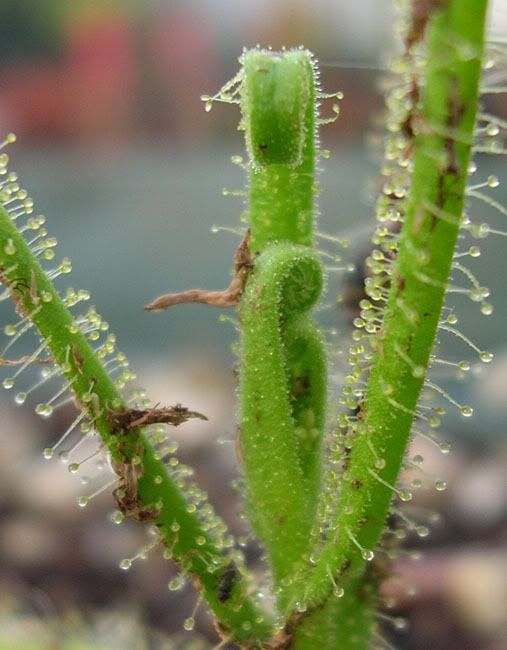 Heres a seed grown D. indica from the ICPS seedbank. Its lacking the glands that the former has entirely. They are both grown the same way with the ICPS indica getting a little more sun throughout the day and they're the same size. Just thought I'd share! Anyone else notice something like this or have any input? I wonder what the purpose of the red glands on the back of the leaf is.  |
|
|
|
Post by Dave Evans on Jun 5, 2007 23:13:02 GMT
Drosera indica is more than one species. That is just the current name for the "group", which was originally thought to be one species. As our understanding of the way these plants relate to each other increases, new names will be proposed. One of them has already been divided out, its name is Drosera hartmeyerorum.
|
|
|
|
Post by SilverKiento on Jun 5, 2007 23:47:00 GMT
Wow! Congrats! You own a very very rare annual drosera. What a pleasant surprise, eh?
|
|
|
|
Post by Khelljuhg on Jun 9, 2007 7:15:22 GMT
Drosera indica is more than one species. That is just the current name for the "group", which was originally thought to be one species. As our understanding of the way these plants relate to each other increases, new names will be proposed. One of them has already been divided out, its name is Drosera hartmeyerorum. Well, I suppose that D. indica is a species highly variable (basically, a species is a group). To me, it seems that D. hartmeyerorum is just a form of it. It could not be so 'digitally' divided. |
|
|
|
Post by shartmeyer on Jun 12, 2007 10:44:26 GMT
To say that D. indica is so "variable" that all plants of that section Arachnopus with really very different emergences on the leaves are only one species sounds very strange to me. If you are consequent and use this state of view for diverse African sundews, section Lasiocephala, or also for the genus Byblis, you will have to reduce the number of species there drastically. Here are examples of really different emergences (modified tentacles) which have a clearly different structure and obviously other strategies to catch prey. The first image by Denis Barthel (for Wikipedia) shows visible yellow emergences with simple hemisphere shaped heads, which are found over the whole leave and the stalk: 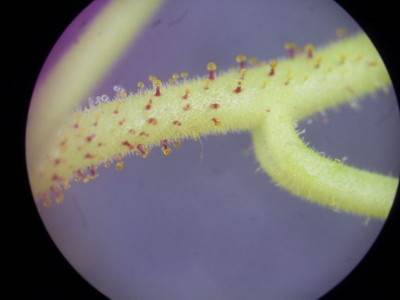 The picture below shows minute (200x magnification) yellow emergences which appear over the whole leaf on D. indica from Australia. The plant grows together with D. hartmeyerorum. Interesting: both species cannot be hybridized: 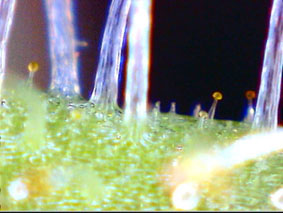 The next picture shows translucend emergences (200x magnification) spread over the whole leaves of a D. indica from Africa: 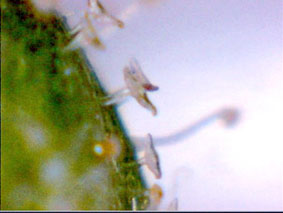 And now the light reflecting much bigger emergences of D. hartmeyerorum, which show a unique lens structure and appear only clearly visible at the leaf base and the bracts of the upright hold florescence to build a kind of light chain. 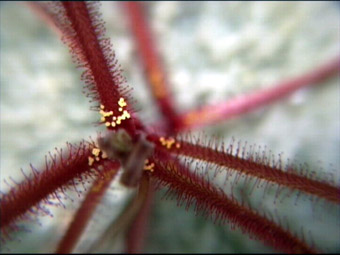 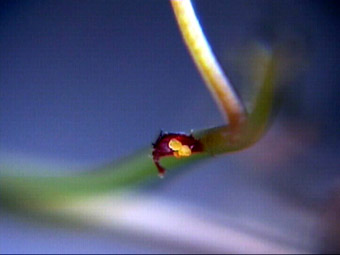 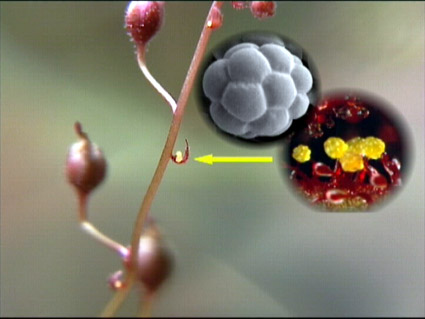 To state all these (and some 3 or 4 more variants) are produced by only one and the same single species is not very logical. Jan Schlauer was certainly not careless, when he decided that the lens headed tentacles of D. hartmeyerorum are clearly different enough to define the plant as a species of its own. No other D. indica "variety" shows such a unique strategy to attract additional prey. The last picture from our DVD contains parts of pictures by Barry Rice and Regina Kettering (REM photo). I am grateful for the permission to use them with our articles and DVDs. More pictures can be found on our website www.hartmeyer.de |
|
|
|
Post by shartmeyer on Jun 19, 2007 8:58:12 GMT
Hello jrfxtreme! Would you be able to make a microscope picture of the red emergences, and would you have also a picture of the seeds? I think it could be worth to register the plant as a cultivar at the moment (because nobody did until now  ), with a chance to become a species on its own after some more investigations. In my opinion the appearance of the red emergences on the lower side of the leaf as well as their structure is clearly different from the other known "varieties". And that means the plant has a typical own characteristic and is therefore clearly to distinguish from others. As a result from my own examinations on different emergences and seed structures of section Arachnopus during the last years, I expect that in a not too far future the D. indica "varieties" will be divided into 4 or 5 species. And that will probably be done by one of those persons who until now claim that "the group - growing from South Africa to Australia - is only one very variable species"  |
|
|
|
Post by Sean Spence on Jun 19, 2007 9:25:33 GMT
Until Dr. Schlauer decides to recognise D. peltata and auriculata as separate species I will never be able to bring myself to believe that there are 4-5 species that can be separated from D. indica.
|
|
|
|
Post by Dave Evans on Jun 20, 2007 1:03:25 GMT
Hello, What does Dr. Schlauer have to do with how you feel about it? Dave E. Until Dr. Schlauer decides to recognise D. peltata and auriculata as separate species I will never be able to bring myself to believe that there are 4-5 species that can be separated from D. indica. |
|
|
|
Post by Sean Spence on Jun 20, 2007 7:58:48 GMT
Hello, What does Dr. Schlauer have to do with how you feel about it? Dave E. Because he is the one who has chosen to separate D. hartmeyerorum from the D. indica group and yet has chosen to keep D. auriculata as a subspecies of D. peltata. Having seen innumerable populations of the latter group of plants in nature, I will never accept that they are not distinct species. In my opinion, the differences that have been used to separate D. hartmeyerorum (let alone 4-5 less distinct potential species) are not as obvious as the differences in the D. peltata group. I'm not necessarily saying that I don't believe that D. hartmeyerorum should not be a species in itself, just that D. auriculata (and D. peltata var. foliosa for that matter) should be. Does that make sense?  |
|
|
|
Post by jrfxtreme on Jun 27, 2007 16:42:51 GMT
Recently both plants have been flowering and their flowers are VERY different. The ICPS indica has little unimpressive white flowers while the "green form" has big penny-sized pink flowers. I could of sworn I took a photo of the ICPS indica flowers but it must of slipped by. The ICPS indica is about at the end of its life after sending out many flower stalks and making a lot of seed. Heres the "green form"'s flower: 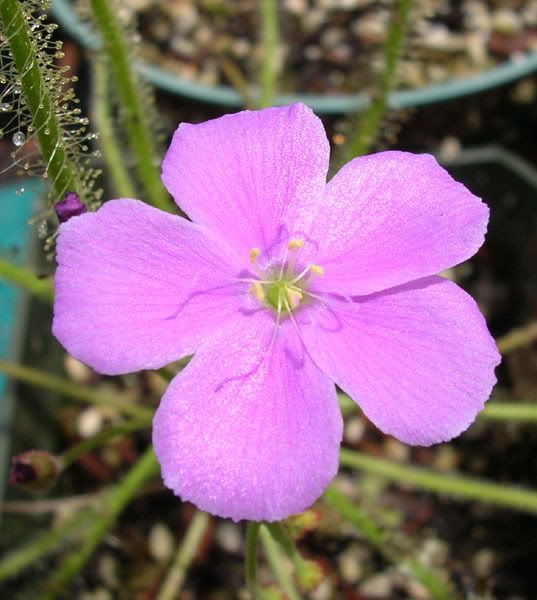 I'll put up a pic of the ICPS indica flower for comparison as soon as I get another blooming plant(or if anyone else is growing this plant, feel free to add a photo!). Sorry but I don't think taking a microscope pic would be a possibility for me. Don't even know how I would go about doing that. I will however try to take a macro pic showing the differences between the ICPS and green form seeds, assuming the self pollination was successful. I think I'll try crossing the two next time I have both in bloom.  |
|
|
|
Post by Dave Evans on Jul 3, 2007 18:51:46 GMT
Hello Sean,
Yeah, but so what? If Jan isn't privy to the same information you are, it is not surprising that he has arrived at a different conclusion. Ask Dr. Schlauer about it and he simply will say it is his opinion and you do not have to agree with it. Everyone who is familiar with these species should be aware that the names D. peltata subsp. auriculata and D. auriculata mean the same thing--meaning there are interchangeable. I do not see much reason to combine the two and will not, it is that simple. The differences between Drosera indica and D. hartmeyerorum are so clear, it is easier to see they are different species as they have different organs. What is there to debate?
All Jan is waiting for to separate D. auriculata from D. peltata is more published work on the subject because it is **not clear to him**. Personally, I have seen and grown a couple clones of both species and they sure do look more alike to each other than they do to any other tuberous, corm-forming species.
However, I do not feel this warrants keeping them (D. auriculata and D. peltata) under one name, not unless someone can prove they are the same species, and I really doubt this will happen (this is in agreement with your observations right?). Jan wants more evidence or "proof" they are actually separate before ranking them as separate species; and I want to see proof they are the same before uniting them--I don't see how this could affect your opinion about a completely different group of plants, which are distantly related to the first and to which the same "rules" will not apply...
|
|
|
|
Post by Khelljuhg on Jul 6, 2007 12:36:46 GMT
It would be so easy if it were so simple...
|
|
|
|
Post by Dave Evans on Jul 25, 2007 6:48:56 GMT
Hello Sean and khelljuhg, It already is. Its name is Drosera auriculata. I don't understand what is difficult about it... Maybe someone could explain. Also, what other species are in this peltata group? I will never accept that they are not distinct species. In my opinion, the differences that have been used to separate D. hartmeyerorum (let alone 4-5 less distinct potential species) are not as obvious as the differences in the D. peltata group. I'm not necessarily saying that I don't believe that D. hartmeyerorum should not be a species in itself, just that D. auriculata (and D. peltata var. foliosa for that matter) should be. Does that make sense?  |
|
|
|
Post by ICPS-bob on Jul 25, 2007 21:08:04 GMT
|
|
|
|
Post by Dave Evans on Jul 25, 2007 22:31:56 GMT
Hello Bob, I understand Jan's take on it. I also think he has requested more information in the form of published articles, but so far nobody seems interested in backing up their ideas... For example, why was Allen Lowrie basically sitting on D. hartmeyerorum for years without publishing it? Dr. Schlauer did and now some people feel it was stolen by Jan and I think this is a truly absurd notion. AFAIK, Allen doesn't even feel that way about it, but I don't think he was too happy either. As a result, other people now don't feel like naming species, at least not through the CPN because they are under the impression that Jan will "steal them" if they submit research to the ICPS. What I have seen is Jan Schlauer is extremely even handed and completely professional.  This idea that if Jan says "this" about somesuch plant so then I must say "that" about some other plant; appears to me to be an extension of this flawed idea about how Jan and the ICPS works. I don't know how many people feel this way about the ICPS, but I have heard this from several different folks over the years and it has really been annoying me for a while... I never saw any way to address it and I hope mentioning it here and now will finally help clear the air. |
|







